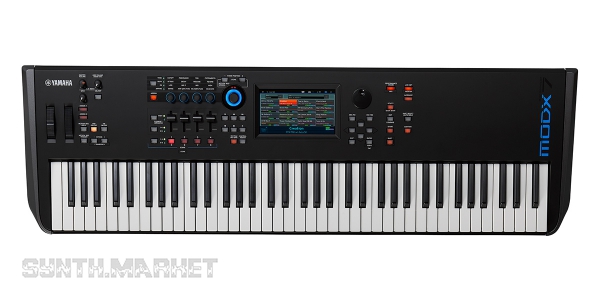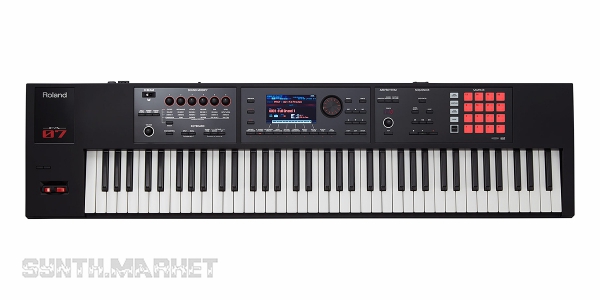Not so long ago, a new line of Yamaha MODX workstations entered the market, and we decided to find out whether its convenience and capabilities really outperform the nearest competitor Roland FA.
Appearance and interface.
Both synthesizers tend to be compact and lightweight, for example, the 61-key version of the MODX weighs 6.6kg and the FA weighs 5.7kg, which is not a significant difference, the sizes of both instruments are about the same, except that the Yamaha is a bit shorter due to pitch and mod wheels moved to the top. Indeed, the 5-octave MODX6 is just couple of inches larger than 4-octave Nord Lead. Keyboards in 61 and 76-key versions of both lines are non-weighted with touch sensitivity and no aftertouch function. The 88-key version of the Roland workstation has an weighted keyboard (Ivory Feel-G Keyboard), the Yamaha has a hammer-key keyboard, which, of course, increases the cost of the product, but is an important factor when choosing an instrument for many keyboard players.
The front panel of the Roland FA is divided into three logical sections: sound control, a display with navigation and an arpeggiator, a sequencer and a sampler. Most of the parameters are controlled by six knobs with variable assignments. It also has a pitch / modulation wheel. An important advantage of Roland in terms of controls is the presence of 16 pads on the right, which facilitates and expands the capabilities of the built-in sampler and sequencer. As for the Yamaha workstation, there are minimum of buttons, it is assumed that the performer will have four knobs with variable assignments, a small FM-X control section and a section responsible for the performance.
Both workstations have quite big screens, Roland has a five-inch graphic LCD display, which is controlled by a number of buttons and a universal encoder. As for the Yamaha, then everything is a bit more convenient for the modern user, because a 7-inch color LCD touchscreen based on thin-film TFT technology is used, and the control is done using the SuperKnob controller. It allows you to control almost anything (up to 128 parameters in one performance) - from mixing functions such as loudness, panning and effect levels to complex synthesizer parameters such as filters, low-frequency modulators and operators. It can also be assigned to one of the FC7 foot controllers for easy control of parameters while playing with two hands.
Sound engine
Roland FA borrowed 2000 tones from the powerful INTEGRA-7 sound module, which imitate not only the sound, but also the behavior of acoustic instruments, which adds to the natural sound. SuperNATURAL Acoustic, SuperNATURAL Synth and SuperNATURAL Drum Kits are loaded into workstations, and in addition to the built-in samples, you can add Axial sound libraries downloaded from the official site, which have a very wide and actively replenishing waveforms' base, including most of the iconic Roland synthesizers. In the internal memory of the workstation, there are also two slots for loading your own waveforms.
Yamaha, in turn, offers a two-part sound engine:
- AWM2 (Advanced Wave Memory 2) — sampling and synthesis engine, which includes 8 fully programmable synthesizers with 18 types of filters for each of the 16 parts, envelope generators for amplitude, pitch and filter, 9 LFOs and three-band EQ;
- FM-X, which is a full 8-operator FM synthesizer and allows you to recreate sounds from the 80s (you can even download and use patches from the legendary Yamaha DX-7 synthesizer).
Also, the MODX’s engine is equipped with a function of Seamless Sound Switching (SSS), which allows you to switch between all settings and effects without delays nor interruptions. But it also has its own limitation: this function will work only with those patterns and performances that have 4 or less parts. As for the additional sound libraries, they can be downloaded from the official site. So far, they are not abundant, but Yamaha promises to constantly replenish the base of samples.
Multitimbral performance and polyphony
In both series of workstations, there are plenty of opportunities for layering timbres on each other, and more than sufficient polyphony. Roland offers 128 voices, as well as 16 multi-timbral parts. Yamaha has 192 voices of polyphony divided into two engines (128 voices for the AWM2 engine and 64 voices for the FM-X engine). And this in itself is quite redundant and does not represent much interest, but there is a really cool aspect of working on the MODX - Motion Control Synthesis Engine, the latest development of the company, which allows you to simultaneously control two sound engines, layering them on each other (up to 8 elements on 1 timbre) and distribute them into zones.
Effects section
The Roland FA series synthesizers offer simultaneous processing of all 16 parts with separate independent MFX multi-effects processors, as well as master section processing with separate TFX effects, such as: DJ FX Looper, Isolator, etc. Among the features of the embedded processors are: 16 different equalizers, three types of chorus, 6 types of reverb, 6 types of “compressor + reverb” combination for drum parts. On the master bus, in addition to TFX effects, there is a compressor that can be optionally replaced with any other effect. In addition to all this, for microphone inputs, synthesizers provide for another 8 different types of reverbs. You can control the processing both on the screen and with the help of controllers on the front panel of the device, which makes this process very flexible and convenient. Also, this entire line has built-in vocoders that can only be used on the first batch.
The Yamaha MODX, in turn, offers a total of 12 types of reverbs, a five-band graphic equalizer for the master channel, a three-band equalizer for the first batch, and a two-band equalizer for the second part. Yamaha also claims that MODX is equipped with powerful digital signal processing functions that provide new effects, performance and, most importantly, sound quality. By these functions, they imply high-quality reverbs, VCM-developed effects implemented on the basis of analog circuit simulation and special effects, such as, for example, a damper resonance effect that enhances the realistic sensation when playing for pianists, and high-resolution reverbs that you can use to move the sound to any point of the concert hall. The developers of this device have tried to make the most versatile set of processing effects: for modern EDM sound, there are Beat Repeat, Vinyl Break, Bitcrusher, Spiralizer effects, which create the illusion that the pitch is constantly rising and falling without becoming higher or lower, side-chain compressors to create a ducking effect etc. To create a retro sound in the synthesizer, there are analog delay effects, a phaser and various amplifier emulations.
Connectivity
Among the switching capabilities, the synthesizers of the Roland FA line have an 3.5mm jack output, main L / MONO / R jacks, as well as 3.5mm TRS, an additional stereo output with a jack type connector, instrumental, microphone and line inputs, inputs for foot switches (3) on jacks, MIDI in out, USB port for software updates and USB port for connecting to a computer and a power connection.
Yamaha MODX is equipped with a professional multi-channel (4 inputs, 10 outputs) USB-audio interface. MODX is also equipped with two A / D inputs (and this is its main difference from the Roland FA line), due to which it can become a central component of any professional recording studio or stage equipment. Connecting with a single cable eliminates the need for an external audio interface. As well as MIDI I / O and two footswitch inputs (assignable / sustain), iOS compatibility is provided.
So, what are the results of this comparison?
In general, for many musicians, the functionality of Roland would still be enough, however, the Yamaha interface seems much more friendly and offers much more in terms of performance. Of course, if the factor of the presence, in fact, of the synthesizer engine matters, then, obviously, the FM-X engine satisfies such a need far better than the ability to load your own waveforms. In general, in this price segment, the Yamaha MODX is a standard, plus a little more. And this can be a decisive factor for many customers.
If more than five years ago the three Japanese manufacturers (Yamaha, Roland and KORG) showed almost complete parity, now their development paths have diverged somewhat. So, Roland left the top price range and concentrated on a segment of performing synthesizers like the JD-Xa, and Yamaha successfully occupied the niche of workstations, releasing Montage and MODX while maintaining the sales of Motif XF and MOXF (available in limited stock, so hurry up).


